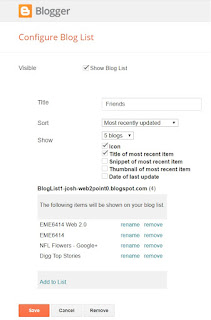Of Definitions and Implications
This has been a week of many firsts, and also of revisiting past habits. In the span of these 6-7 days, I have already explored many tools, attempted to clarify my understanding of Web 2.0, and continue my expansion of privacy issues.
And here are my reflections...
I have used some tools and sites based on recommendations, and through some exploration. I am always willing to try but my first thought would inevitably default to one of "what is the valued proposition" and "what utility does it provide me." Being completely honest, I could already see how some tools (Twitter, Feedly) I will not continuing using. However, things like blogs, blogrolls, and social networking site such as LinkedIn, I see as useful and may go on to maintain the profile.
Benefiting from a previous class, my first reflection is that while it was clear what the differences were between Web 1.0 and 2.0, it is equally as important to know that learning takes place differently because of this. Web 2.0 allows greater interactivity and collaboration that was not possible within a Web 1.0 architecture. It was also important to note that the tools and social media only form part of the characteristic the web. Simply put, the web can exist without social media, but not the other way round. Even during discussions this week, I could see how easily they could be seen as synonymous.
On the other hand, I was faced with a similar issue with definitions - distinguishing community and network. But in-class discussions really helped me to differentiate the two. While they may overlap in certain areas and at certain times, I now see communities as a group with a common cause and shared identity. There are usually boundaries (defined, or otherwise), and rules (formal, or informal). Some classmates also explained about the level of trust and the focus on reciprocal relationships. This differs from a social network, where like a electrical network, there are nodes (persons) and connections (relationships). These relationships could be established through familial, professional or acquaintances.
Finally, in my previous post, I continued with my attempt to spread the issues of privacy when using the internet. I maintain that merely by using the internet in our daily lives (online shopping, social media trawling, etc) enough of our real profiles exist. And the only defence we have, is the hope that we do not become the targets of malicious intent. This topic has become of particular interest to me since the realisation not too long ago (previous class about big data). Perhaps in the following few weeks, I will scour the internet to see what steps, or tools could be use to minimise the probability of inappropriate use of our data.
Till the next post,
Josh out.
And here are my reflections...
I have used some tools and sites based on recommendations, and through some exploration. I am always willing to try but my first thought would inevitably default to one of "what is the valued proposition" and "what utility does it provide me." Being completely honest, I could already see how some tools (Twitter, Feedly) I will not continuing using. However, things like blogs, blogrolls, and social networking site such as LinkedIn, I see as useful and may go on to maintain the profile.
Benefiting from a previous class, my first reflection is that while it was clear what the differences were between Web 1.0 and 2.0, it is equally as important to know that learning takes place differently because of this. Web 2.0 allows greater interactivity and collaboration that was not possible within a Web 1.0 architecture. It was also important to note that the tools and social media only form part of the characteristic the web. Simply put, the web can exist without social media, but not the other way round. Even during discussions this week, I could see how easily they could be seen as synonymous.
On the other hand, I was faced with a similar issue with definitions - distinguishing community and network. But in-class discussions really helped me to differentiate the two. While they may overlap in certain areas and at certain times, I now see communities as a group with a common cause and shared identity. There are usually boundaries (defined, or otherwise), and rules (formal, or informal). Some classmates also explained about the level of trust and the focus on reciprocal relationships. This differs from a social network, where like a electrical network, there are nodes (persons) and connections (relationships). These relationships could be established through familial, professional or acquaintances.
Finally, in my previous post, I continued with my attempt to spread the issues of privacy when using the internet. I maintain that merely by using the internet in our daily lives (online shopping, social media trawling, etc) enough of our real profiles exist. And the only defence we have, is the hope that we do not become the targets of malicious intent. This topic has become of particular interest to me since the realisation not too long ago (previous class about big data). Perhaps in the following few weeks, I will scour the internet to see what steps, or tools could be use to minimise the probability of inappropriate use of our data.
Till the next post,
Josh out.

Comments
Post a Comment